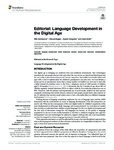Editorial: Language Development in the Digital Age
| dc.contributor.author | Vulchanova, M | |
| dc.contributor.author | Baggio, G | |
| dc.contributor.author | Cangelosi, Angelo | |
| dc.contributor.author | Smith, L | |
| dc.date.accessioned | 2017-10-11T09:45:59Z | |
| dc.date.available | 2017-10-11T09:45:59Z | |
| dc.date.issued | 2017-09-05 | |
| dc.identifier.issn | 1662-5161 | |
| dc.identifier.issn | 1662-5161 | |
| dc.identifier.other | ARTN 447 | |
| dc.identifier.uri | http://hdl.handle.net/10026.1/10045 | |
| dc.description.abstract |
INTRODUCTION The digital age is changing our children’s lives and childhood dramatically. New technologies transform the way people interact with each other, the way stories are shared and distributed, and the way reality is presented and perceived. Parents experience that toddlers can handle tablets and apps with a level of sophistication the children’s grandparents can only envy. In Great Britain, a recent survey of preschoolers shows that a rising number of toddlers are now put to bed with a tablet instead of a bedtime story. In the USA, a telephone survey of 1,009 parents of children aged 2–24 months (Zimmerman et al., 2007a) documents that by 3 months of age, about 40% of children regularly watched television, DVDs or videos, while by 24 months the proportion rose to 90%. Moreover, with the advance and exponential use of social media, children see their parents constantly interacting with mobile devices, instead of with people around them. Still, research in the US indicates that assistive social robots seem to have a favorable effect on children’s language development (Westlund et al.). Existing theories of language acquisition emphasize the role of language input and the child’s interaction with the environment as crucial to language development. From this perspective, we need to ask: What are the consequences of this new digital reality for children’s acquisition of the most fundamental of all human skills: language and communication? Are new theories needed that can help us understand how children acquire language? Do the new digital environment and the new ways of interaction change the way languages are learned, or the quality of language acquisition? Is the use of new media beneficial or harmful to children’s language and cognitive development? Can new technologies be tailored to support child growth and, most importantly, can they be designed to enhance language learning in vulnerable children? These questions and issues can only be addressed by means of an interdisciplinary approach that aims at developing new methods of data collection and analysis in a longitudinal perspective. This type of research is however not yet documented. | |
| dc.format.extent | 447- | |
| dc.format.medium | Electronic-eCollection | |
| dc.language | eng | |
| dc.language.iso | en | |
| dc.publisher | Frontiers Media | |
| dc.subject | language development | |
| dc.subject | digital technology | |
| dc.subject | learning | |
| dc.subject | human-robot interaction | |
| dc.subject | interdisciplinary approaches | |
| dc.title | Editorial: Language Development in the Digital Age | |
| dc.type | journal-article | |
| dc.type | Editorial | |
| plymouth.author-url | https://www.webofscience.com/api/gateway?GWVersion=2&SrcApp=PARTNER_APP&SrcAuth=LinksAMR&KeyUT=WOS:000412000800001&DestLinkType=FullRecord&DestApp=ALL_WOS&UsrCustomerID=11bb513d99f797142bcfeffcc58ea008 | |
| plymouth.volume | 11 | |
| plymouth.publication-status | Published | |
| plymouth.journal | Frontiers in Human Neuroscience | |
| dc.identifier.doi | 10.3389/fnhum.2017.00447 | |
| plymouth.organisational-group | /Plymouth | |
| plymouth.organisational-group | /Plymouth/Faculty of Science and Engineering | |
| plymouth.organisational-group | /Plymouth/Research Groups | |
| plymouth.organisational-group | /Plymouth/Research Groups/Institute of Health and Community | |
| plymouth.organisational-group | /Plymouth/Research Groups/Marine Institute | |
| dc.publisher.place | Switzerland | |
| dcterms.dateAccepted | 2017-08-22 | |
| dc.identifier.eissn | 1662-5161 | |
| dc.rights.embargoperiod | Not known | |
| rioxxterms.versionofrecord | 10.3389/fnhum.2017.00447 | |
| rioxxterms.licenseref.uri | http://www.rioxx.net/licenses/all-rights-reserved | |
| rioxxterms.licenseref.startdate | 2017-09-05 | |
| rioxxterms.type | Journal Article/Review |


